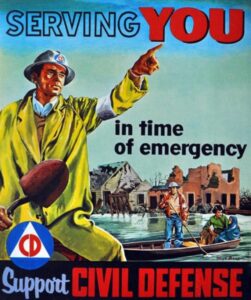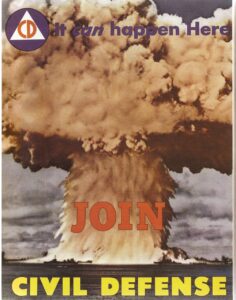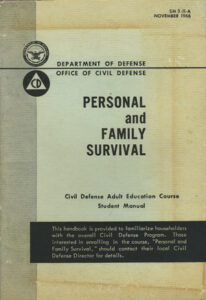All Roads Lead to Civil Defense
All Roads Lead to Civil Defense: Survival is a local Issue.
 Civil defense is the organizing and training of civilians to play key roles in a community’s survival. Another term for this, coined by Civil Defense Virginia, is “continuity of community.” The concept is simple: A community’s citizens, in partnership with their emergency management and local government, planning and preparing for disasters and having the ability to take care of their own. This is something that currently is not in common practice – and this needs to change.
Civil defense is the organizing and training of civilians to play key roles in a community’s survival. Another term for this, coined by Civil Defense Virginia, is “continuity of community.” The concept is simple: A community’s citizens, in partnership with their emergency management and local government, planning and preparing for disasters and having the ability to take care of their own. This is something that currently is not in common practice – and this needs to change.
Current FEMA Administrator Brock Long and former FEMA Administrator Craig Fugate – emergency management leaders serving in vastly different administrations – have both told Congress essentially the same thing. It has been rare to see bipartisan agreement on any subject in the past decade, so we should all pay attention.
On November 30, 2017, current FEMA Administrator Brock Long told Congress:
We have to do more pre-disaster mitigation. Pre-disaster mitigation is the key to becoming more resilient and reducing disaster impact. We have to ensure that state and local governments…have their own life sustainment commodities capabilities and the federal government is not shouldering the entire burden…The key resiliency is held at the local level of government…it’s going to have to be a whole community effort on the pre-disaster side.
On March 30, 2011, then FEMA Administrator Craig Fugate told Congress:
Government can and will continue to serve disaster survivors. However, we fully recognize that a government-centric- approach to disaster management will not be enough to meet the challenges posed by a catastrophic incident. That is why we must fully engage our entire societal capacity, leveraging trade associations, non-governmental organizations including those that represent different linguistic and ethnic minority groups, faith-based organizations, private industry, and social and fraternal organizations. These are the organizations that provide the bulk of services to communities every day, and to the extent that they are able, they should continue to be the primary provider of such services in a disaster. The quicker these entities are able to get back on their feet, the faster communities as a whole will be able to recover.
FEMA’s underlying message has not changed in the last two administrations: survival is a local issue. This is especially true if we suffer a national-scale disaster in the United States. If we are preparing for a “worst-case scenario” this message means we need local government and communities to be able to take care of themselves for long periods – weeks or months – when no outside assistance is available.
All Roads Lead to Civil Defense: This is a national security issue.
 Local preparedness and resilience is essential to the national security of the United States: If there is a national-scale disaster, such as a loss of the electric grid for a substantial period, FEMA cannot helicopter in MREs and water to 35,000 towns and cities in the U.S.
Local preparedness and resilience is essential to the national security of the United States: If there is a national-scale disaster, such as a loss of the electric grid for a substantial period, FEMA cannot helicopter in MREs and water to 35,000 towns and cities in the U.S.
To the extent that 35,000 towns and cities would be looking to the state and federal government to rescue them, the outcome would be cataclysmic. Millions of people will die of starvation, disease, and exposure waiting to be rescued.
Therefore, each local government, emergency manager and citizen plays a crucial role in the preparedness and resilience of the U.S. as a whole. And they must do this by working to make their local community prepared and resilient.
Developing local civil defense organizations is a resource multiplier for communities – and for the country. We cannot prepare 35,000 towns and cities and over 323 million people from the federal level. We cannot do it from the state level. It must be done from the community level by each individual community.
All Roads Lead to Civil Defense: The writing is on the wall – we must read it.
This is not a new philosophy. For one, FEMA has been stressing the importance of community preparedness for years. Exhibit A is an oldie but goodie from FEMA in 2011: “A Whole Community Approach to Emergency Management: Principles, Themes, and Pathways for Action.” So, in 2011 FEMA said:
FEMA began its national dialogue with a proposition: A community-centric approach for emergency management that focuses on strengthening and leveraging what works well in communities on a daily basis offers a more effective path to building societal security and resilience. By focusing on core elements of successful, connected, and committed communities, emergency management can collectively achieve better outcomes in times of crisis, while enhancing the resilience of our communities and the Nation.
Here’s exhibit B. In August of 2012, a bipartisan group of representatives in Congress introduced House Resolution 762. Unfortunately, the resolution never saw a vote and died with the 112th Congress.
The proposed resolution:
- encourages every community to develop its own “civil defense program” working with citizens, leaders, and institutions, ranging from local fire halls, schools, and faith-based organizations, to create sustainable local infrastructure and planning capacity, so that it might mitigate high-impact scenarios and be better prepared to survive and recover from these worst-case disaster scenarios and be better able to affordably and sustainably meet the needs of the community in times of peace and tranquility;
- encourages every citizen to develop an individual emergency plan to prepare for the absence of government assistance for extended periods;
- encourages each local community to foster the capability of providing at least 20 percent of its own critical needs, such as local power generation, food, and water, while protecting local infrastructure whenever possible from the threats that threaten centralized infrastructure; and to do so with the urgency and importance inherent in an all-of-nation civil defense program developed by citizens and their local communities; and
- encourages state governments and federal agencies to support the ability of local communities to become stronger, self-reliant, and better able to assist neighboring communities in times of great need.
I believe this resolution speaks for itself, and it is unfortunate that it didn’t pass. However, a good idea does not need to pass Congress to be a good idea. This is a great start for a local resolution in your town or a state resolution. The message is clear.
All Roads Lead to Civil Defense: Threats have evolved, and so must we.
For over two decades, the federal government and Congress have studied, researched, and held hearings on threats to the electric grid. (Click here for a comprehensive list of federal government documents on threats to the grid.) There can be no debate that a loss of the electric grid for any length of time – whether from natural or man-made cases – would be a catastrophic disaster. And one for which we are woefully unprepared. And threats to the grid continue to emerge.
 We face the increasing threat of a cyber-attack, such as the one that caused the Ukraine blackout in 2015. We face the 100% certain future threat of “space weather” or geomagnetic disturbance (GMD) such as the Quebec blackout of 1989. We face the threat of a coordinated attack by terrorists on key grid facilities (see the attack on the Metcalf substation). We face the threat of extreme weather as well as the fragility and complexity grid – remember, the Great Northeast Blackout of 2003. These threats are now joined by a nuclear North Korea which has specifically threatened an electromagnetic pulse (EMP) attack, and other state and non-state actors such as Iran and terrorist organizations.
We face the increasing threat of a cyber-attack, such as the one that caused the Ukraine blackout in 2015. We face the 100% certain future threat of “space weather” or geomagnetic disturbance (GMD) such as the Quebec blackout of 1989. We face the threat of a coordinated attack by terrorists on key grid facilities (see the attack on the Metcalf substation). We face the threat of extreme weather as well as the fragility and complexity grid – remember, the Great Northeast Blackout of 2003. These threats are now joined by a nuclear North Korea which has specifically threatened an electromagnetic pulse (EMP) attack, and other state and non-state actors such as Iran and terrorist organizations.
America – 35,000 towns and cities and over 323 million people – face existential threats. And yet, we generally prepare only for local and regional disasters that we have seen in the past (e.g., floods, tornadoes, hurricanes, earthquakes, etc.). As former FEMA Administrator Craig Fugate notes: “We plan for what we are capable of responding to.” We are not truly preparing for “all hazards” unless we begin to prepare for a nation-wide disaster such as the loss of the electric grid.
All Roads Lead to Civil Defense: Serving the under-served
I read a recent article that asked: “Is FEMA’s new preparedness posture a death sentence for the underserved?” It is a great question but I would argue that the opposite is true.
As Brock Long told Congress on November 30, 2017 we do not have a true culture of preparedness in the United States. I doubt many of us would argue this point. So if the baseline right now is that 99% of communities are unprepared to “help themselves” for a long period of time in a national-scale disaster (pick whatever percentage you think is accurate), this means that 99% of the country is expecting to be rescued – immediately after a disaster – with state and federal resources that we all know won’t stretch to fit this bill. This present result of our lack of a preparedness culture endangers the entire country. This does an even greater disservice to the under-served. Everybody in the country is in line for “rescue” right now.
So let’s say that all of us take up the call and build a true culture of preparedness at the community level. One at a time across the country we see community non-profit civil defense organizations form where citizens, their local governments, civic groups, businesses – all stakeholders in the community – work together to change the preparedness culture in their particular community. One by one at first, but with the momentum that we the local leadership can provide, soon we see scores, then hundreds, then thousands of communities across the country taking ownership of their pre-disaster mitigation, preparedness and resiliency. This benefits the under-served within those communities. Not only does it make more and more of America prepared and resilient to survive for a long period of time, it also leaves more state and federal resources available for places where they are really needed – including the truly under-served and challenged areas.
And if these individual communities are more prepared and more self-reliant, they are more able to assist neighboring communities that need help.
All Roads Lead to Civil Defense: Conclusion
What is the downside to building a culture or preparedness in the United States? I see none. What is the downside to new non-profit local civil defense organizations playing a key role in doing this? I see none. In fact, I see this as strengthening the resilience of the entire nation. Each community that works towards this goal is contributing to the overall national security of the whole.
If we are 99% unprepared across all communities now – the under-served are in the same “rescue me” line with every other community. If we substantially shorten the line, we are serving everybody and making more state and federal resources available to communities where they are immediately needed.
Our very survival as a nation in a (plausible) worst-case scenario depends on each individual community working to be as prepared and as resilient as it can be. As Aristotle noted: “the whole is greater than the sum of its parts.”
